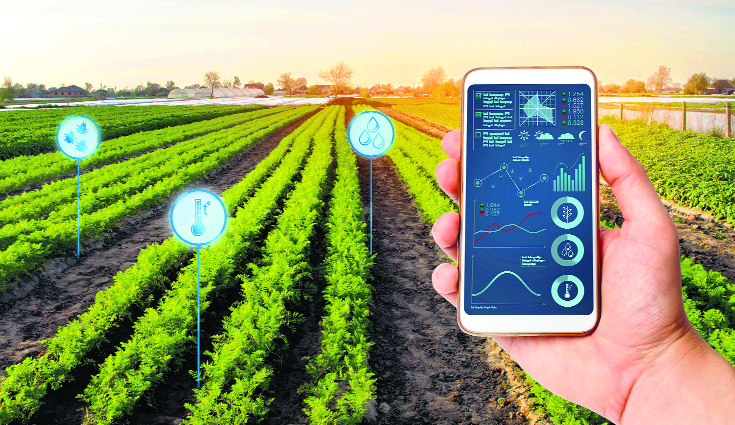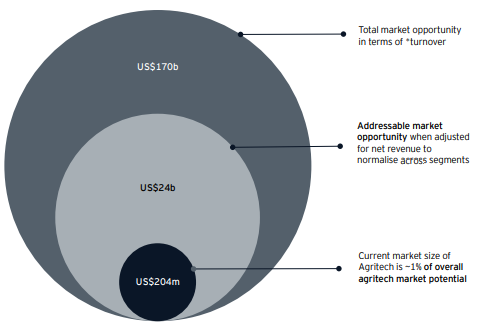Even in the midst of India’s expanding and modernising economy, agriculture is a major driving factor when it comes to economic growth. Contributing upwards of $ 2,842 Billion to the Indian GDP in 2018 alone, Agriculture amounted for 16% of India’s GDP. More importantly, agriculture is also the largest employer amounting for upwards of 40% of all employment in India. In addition to helping the domestic economy grow, India’s agricultural industry is a major global player being the largest producer of spices, pulses, tea, cashew, maize, to name a few and being major suppliers of wheat, rice, fruits, cotton, etc as well.

Such global prevalence of the agricultural sector does not seem likely once you look at the methods India’s farmers are restricted to even today. The modern farming scene is mostly no different than the one we have been observing for the past hundred years or so. In short, India’s farming industry has been severely plagued by lack of modernisation and innovation. Research group EY in its report mentions a plethora of other bottlenecks such as lack of adequate data which prevents the adoption of financial services, post-harvest loss due to degraded supply chain amounting to $ 13 Billion in lost profits, limited sales channels, lack of digital infrastructure, to name a few.
Introducing Agri-Tech
To understand how the aforementioned roadblocks can be cleared to better meet the market demands and foster the growth of India’s largest employers, we turn our attention to technology. Agri-Tech is usually defined as an ecosystem of companies leveraging technology to provide products and/or services in order to increase the overall yield, efficiency, and profitability of for farmers across the industrial value chain.

In essence, Agri-Tech is the long overdue industrial revolution driven by new and pragmatic technological advancements such as data analytics which aids in precision agriculture and farm management such as the services offered by start-ups like CropIn or BharatAgri which strives to improve productivity through insights on weather and soil health, data modelling to guide optimal resource allocation, and risk models to predict credit profiles for farmers. However, they are not the only ones and big data is not the only technology that improvements are being made in.
Solving the issue of market linkage and lack of availability of platform for the farmers is DeHaat which is one of the largest growing Agri-Tech pioneers in India and is striving to manage the supply chain tech and output market linkage by creating better returns for farmers through higher transparency and larger reach on their online platform facilitating price discovery for better input and output.
Moving on to solving the problem of quality management and traceability, we find companies like Intello Labs and Agricx working on important automotive aspects such as crop quality monitoring and improvements in yield through imaging and/or AI culminating in output grading and yield classification through big data pioneering. Finally, one of the largest innovations happens to be in the field of farm mechanization and automation to help overcome labour shortage as more and more individuals subscribe to the idea of urban migration, companies like TerraCroft and Tartan Sense are developing robotics and drone solutions to improve on time taken to achieve yield and compensate for labour deficit.
The Government’s Prerogative

Over the past couple of years, there have been significant support through policy changes by the government in a bid to help farmers modernise and move ahead with an impetus on the Agri-Tech sector. Some of the broadest drivers emanating from the government’s support through policy has supported the farmer community and led to Agri-Tech’s growth by setting up 10,000 FPOs to boost farmer’s income and upwards of 700 Krishi Vigyan Kendra, in addition with 684 Agri-Tech Management Agencies for technology distribution among farmers.
In addition to these, government’s steps towards providing access and mechanisation options in order to better improve productivity and yield for farmers by setting up better access to Agri inputs through new innovative models such as Farming-as-a-Service wherein companies are converting fixed cost to variable cost by facilitating provision of Agri-equipment fleet on pay-per-use basis. None of these however, would make any sense if there is lack of communication and/or awareness regarding the existence of policies as such. To that extent there has been an increase in internet penetration across the nation and specifically in rural India as well with about 60% of the rural users being on the internet for 15-30 minutes a day. Apart from this, farmers are also given access to information regarding weather alerts, crop pandemics, standard best practices, and output forecast.
Finally, the conjugation of Agri-Tech innovators with large corporation can help expand the reach and impact of such ventures. For instance, Gurugram based start-up MoooFarm collaborating with Microsoft to tackle pressing issues such as mastitis using machine learning or in the case of The Weather Company, an initiative supported by IBM’s Watson Cloud Computing technology has been providing hyperlocal weather information to farmers along with information on soil moisture and temperature.
Let’s Explore the Market
As we have already established, without a doubt India’s Agri industry by its own is a lifeline for the national economy. However, as Agri-Tech market opportunity is spread across multiple segments, it is of vital importance that we assess the market potential for each such segment to assess the market gap as well as monitor the progress made. To understand the growth potential in this industry we turn our attention to the bottom-up approach across each segment to primarily assess the size and growth of the underlying market.

Intermediaries in the agriculture value chain have built trust with farmers over generations and Agritech
players need to therefore aim to enable these intermediaries through technology-led solutions instead of
work with a mindset of replacing them. Creating a partnership oriented approach is the most effective way
to enhance value and scale this sector to serve the growing needs of both farmers and consumers. Such
technology-led interventions and on ground partnerships present an opportunity of ~US$25b.-nukul upadhaye, cofounder bijak
The Bottom Line
As India nestles deeper into its globalised position, in order to handle the stupendous demand and keep up with its global counterparts, it becomes incredibly important for India to modernise. With heavy investment in research and development and a growing sense of urgency across the various echelons of governments both national and state, it is becoming apparent that a new agricultural revolution is afoot. To that extent, significant growth has been noticed and even though the technology is in its nascent stage, as the market matures there will be a rising stream of adopters and expansion would be all but inevitable. With that being said, if you are interested in learning how the new farm bills will affect the market, make sure to check out our cover story by clicking here.

